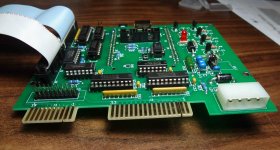GreyHairedDECfan
Experienced Member
Wednesday's update. I found a tutorial on unsticking the RD53 drives. Was able to free up the heads after going through that. Still, DU0 reports as Not ready.
I really wish there was some visual indication that it's getting any signals from the controller. Unfortunately on the RQDX3 controller there are no lights, nor are there any on the drive itself. So I can't see (and I can't hear) that it's attempting to do anything. The only thing I know is that the controller seems to see the drive, since if I unplug it it reports Non-existent drive. I just can't get it to read from the drive (or so it seems).
I really wish there was some visual indication that it's getting any signals from the controller. Unfortunately on the RQDX3 controller there are no lights, nor are there any on the drive itself. So I can't see (and I can't hear) that it's attempting to do anything. The only thing I know is that the controller seems to see the drive, since if I unplug it it reports Non-existent drive. I just can't get it to read from the drive (or so it seems).

